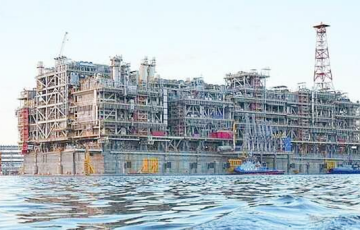LNG Project Of Putin's Friend Trapped
- 5.09.2024, 14:08
- 8,050

No one wants to buy it because of sanctions.
All three tankers of the shadow LNG fleet that tried to export the fuel from the US-sanctioned Arctic LNG 2 project never delivered it to buyers. Two of them headed instead to a floating storage facility near Murmansk. The longer the LNG stays on the ships, the more of it is lost in the transport process, The Moscow Times reported.
The Pioneer tanker arrived at Novatek's Arctic LNG 2 in early August, followed about 10 days later by the Asya Energy and another 10 days later by the Everest Energy, Bloomberg reported. The first of them, having travelled around Europe, managed to reach the eastern Mediterranean, and the second initially headed west following it. However, it was not possible to organise deliveries with the help of the shadow LNG fleet, which Russia started to create on the model of the shadow oil fleet. On August 23, the U.S. imposed sanctions against these tankers and the Indian Ocean Speedstar Solutions, which was registered in June and operates only these three ships.
In late August, Pioneer reloaded fuel onto another, non-sanctioned tanker in Egypt's Port Said, and both ships have remained in place since then, the Financial Times reported, citing satellite imagery and vessel tracking data. And the Everest Energy, according to the newspaper, docked at Saam FSU, the world's largest floating storage facility in Murmansk region, apparently unloaded LNG and headed back to Arctic LNG 2. The Asya Energy tanker, which initially travelled westwards around Norway, has returned to Russian waters and is now near Saam FSU, ICIS vessel tracking data shows.
Pioneer and Asya Energy tried to conceal their visits to the Arctic LNG 2 plant east of the Yamal peninsula. While they were travelling to it to pick up cargo, their transponders were showing that they were supposedly in the Barents Sea northeast of Norway. Following the recent imposition of sanctions against the tankers, the Republic of Palau, the Pacific island nation whose flag they were flying, suspended their registration, the FT and specialised publication of gCaptain reported. The vessels lost their registration while under investigation for suspected deactivation or incorrect signalling by transponders during voyages to the under-sanctioned Arctic LNG 2 project, gCaptain specifies.
Since the shadow fleet consists of older tankers, LNG shipping losses, which can be as high as 0.25% of cargo per day, become an issue, the publication notes: ‘Pioneer took on cargoes on August 3, so a month later, the potential losses are approaching 7.5%’. The Asya Energy is a somewhat newer vessel, but it again has losses that could be as high as 3-4 per cent of cargo.
The 360,000 cubic metre Saam UGS storage facility, built for Novatek's offshore transshipment complex in Murmansk region, has not yet been used. Reloading LNG into the storage facility will reduce the loss of LNG from being on a tanker, gCaptain notes. It ‘highlights the problems Russia is having in finding buyers for its sub-sanctioned LNG,’ Kpler analysts wrote.
Kjell Eikland, managing director of Norwegian consulting firm Eikland Energy, said to the FT:
‘If [before the latest US sanctions] there was some interest from buyers, it has certainly disappeared now’.
Vladimir Putin was relying heavily on the Arctic LNG 2 project run by Leonid Mikhelson, Novatek's chief executive. It was supposed to make a major contribution to the planned tripling of LNG production to 100 million tonnes by 2030. Arctic LNG 2 is to produce almost 20 million tonnes when the three production lines are fully operational.
The export was supposed to start at the beginning of this year, but the sanctions imposed at the end of 2023 prevented it. The first line is now operating at just under 50 per cent of rated capacity because there is no one to ship gas to because of the sanctions, says Mehdi Tuil, lead LNG specialist at Calypso Commodities. At this level of production, Saam UGS can provide buffer storage for about 16 days - or ‘up to 27 days with [Line 1] utilisation at 30 per cent, which is the minimum required to sustain the liquefaction process’.











